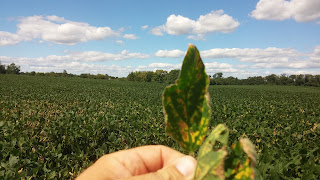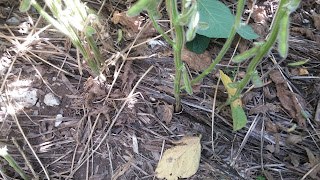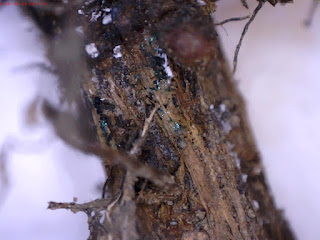Corn Leaf Diseases – Adapted from Purdue University Plan Pathology.
Corn Leaf Diseases – Adapted from Purdue University Plan Pathology.
Many of my colleagues are reported that they viewed numerous hybrids exhibiting gray leaf spot infections. However it is wise to determine the hybrids performance in resisting plant diseases. The major rule in managing leaf diseases is similar to wheat in that one strives to keep the leaf that feeds the ear clean of disease. Infections below that point typically have less of an impact on corn yields. Most if not all recommendations particularly for no till corn will stem in hybrid selection to manage diseases. Applications during tasseling are also an option. Data from across the east and Midwest is variable and the key to determine the need to treat is related to specific field conditions. In some studies completed with industry and Extension involvement it appears that fields that have observable disease infecting the lower leaves, fields with hybrids that are prone to disease infection, and reduced tilled fields that are showing signs of infection are fields that may prove to return a profit.
|
CORN
Disease Name: Gray Leaf Spot Pathogen: Fungus. Cercospora zeae-maydis Symptoms: Initial lesions appear as greenish black water soaked circular areas with chlorotic halos, expanding into oval and then the diagnostic parallel sided rectangular brownish gray lesions. Conditions: Infection is favored by extended warm, wet, humid weather. Inoculum Survival: Infected crop residue (leaves and leaf sheaths). Inoculum Dispersal: Airborne spores. Management: Select hybrids with resistance (tolerance based on risk), two year crop rotation, cleanly plow under infected residue. |
|
CORN
Disease Name: Anthracnose Leaf Blight Pathogen: Fungus. Colletotrichum graminicola Symptoms: Small, oval to elongated water-soaked lesions enlarge to become brown, spindle shaped spots with yellow to reddish-brown borders. Lesions may coalesce and blight entire leaves. Older lesions will turn gray in the center with small black specks (acervuli with sterile black hairs). Leaf blight may be followed by top kill and stalk rot. Leaf blight rarely causes large yield losses. Stalk rot phase is most important (see Anthracnose Stalk Rot). Conditions: Favored by cool to warm, wet, humid weather, continuous corn with reduced tillage. Inoculum Survival: Infected crop residue (leaves, leaf sheaths and stalks), seed (endosperm). Inoculum Dispersal: Airborne spores. Management: Resistant hybrids, rotate corn with nongrass crops. Cleanly plow under infected residue. |
|
CORN
Disease Name: Common Corn Rust Pathogen: Fungus. Puccinia sorghi Symptoms: Initial symptoms are chlorotic flecks on leaf surfaces. Flecks develop into oval to elongate reddish brown powdery pustules on upper and lower leaf surfaces. Reddish brown spores break through the leaf epidermis. Pustules become brownish-black as they mature. Usually not a serious disease in hybrids. Conditions: Disease favored by cool (66 F optimum) humid weather. Inoculum Survival: Spores blown into the Midwest from the South. Does not survive winter in Indiana, except possibly in rare years along the Ohio River. Inoculum Dispersal: Airborne spores. Management: Resistant hybrids. Foliar fungicides may be useful in seed production fields. |
|
CORN
Disease Name: Southern Corn Rust Pathogen: Fungus. Puccinia polysora Symptoms: Similar to common rust except pustules occur almost exclusively on the upper leaf surface, rarely on lower. Pustules are more orange than brick-red and slower to break through epidermis of leaf than common rust pustules. Conditions: Favored by high humidity and temperatures around 80 F. Inoculum Survival: Spores blown into the Midwest from the South. Does not survive winter in Indiana, except possibly in rare years along the Ohio River. Inoculum Dispersal: Airborne spores. Management: Resistant hybrids. Foliar fungicides may be useful in seed production fields. |
|
CORN
Disease Name: Northern Corn Leaf Blight Pathogen: Fungus. Exserohilum turcicum Symptoms: Long cigar-shaped gray-green or tan lesions. Conditions: Favored by extended wet, cool, humid weather, minimum tillage, continuous corn. Usually occurs during or after pollination. Inoculum Survival: Infected crop residue (leaves, husks, stalks). Inoculum Dispersal: Airborne spores. Management: Resistant hybrids. Foliar fungicides may be useful in seed production fields. Cleanly plow under infected residue. |
|
CORN
Disease Name: Northern Leaf Spot Pathogen: Fungus. Helminthosporium carbonum (Race 3) Symptoms: Narrow, small, linear to oval shaped leaf lesions. Lesion type may vary with the genotype of host and isolate. Lesions are grayish tan and surrounded by a light to darkly pigmented (usually purple) border. Chain-like leaf lesions are often produced. Conditions: Favored by moderate temperatures and high relative humidity, minimum tillage, continuous corn. Inoculum Survival: Infected crop residue (leaves, husks, stalks, seed). Inoculum Dispersal: Airborne spores. Management: Resistant hybrids. Disease is primarily a problem in seed production fields with certain highly susceptible inbreds. Foliar fungicides may be useful in seed production fields. Cleanly plow under infected residue. |















